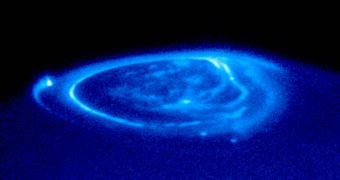Auroras are, arguably, some of the most beautiful manifestations that can be seen on the night sky, if you live at high latitudes, near the Arctic and Antarctic Circles. Caused by high-energy particles slamming into the planet's magnetosphere, these phenomena originate on the surface of the Sun, where emissions of protons and electrons, caused by swirling plasma, are ejected in all directions, mostly in the form of solar winds. The intensity of these winds determines the brightness and visibility of the auroras, as they appear back on Earth.
It's up to the US National Oceanic and Atmospheric Administration (NOAA)-operated Space Weather Prediction Center (SWPC) to ensure that we are forewarned when major emissions are generated by the Sun. The fact that the star is located some 93 million miles away is of great help, as it means that we have at least a day until the solar winds reach us, once they are generated.
This is important because they have the potential to severely disturb a number of systems back on Earth, including transformers and power grids, satellites and GPSes, high-frequency communications, and they even pose a threat to the lives of astronauts on the International Space Station (ISS) or shuttles in low-Earth orbit.
Auroras occur when these particles emitted by the Sun hit the planet's magnetic field. This can be seen in the sky, in almost all pictures. Those sightings in which the auroras appear as curtains actually occur when the flow of protons and electrons in the solar wind streams on Earth's magnetic lines, which are thus evidenced to the naked eye. These phenomena are best visible from Canada, Alaska, Greenland, Scandinavia and Northern Russia, in the Northern Hemisphere, and from Antarctica, in the Southern one.
Though they occur all the time, on only a small number of days are they strong enough to be visible. For this reason, they are best observed when a number of conditions is met. The mid-winter period of the solar cycle maximum is the best time, astronomers and planetary scientists say. For the current cycle, the maximum will occur in 2012-2013. The best hours are between 10:00 pm and 2:00 am local time, but the most important condition that has to be met is for the observer to be located at a high latitude, as close to the pole as possible, ScienceDaily informs.
These events do not occur only on Earth. Technically, they can take place on any formation in the solar system that has its own magnetic field. For example, auroras have been photographed on Jupiter as well, in the ultraviolet wavelength. Additionally, evidence of these phenomena has been noticed on Uranus, Neptune, and Saturn as well, using the Hubble Space Telescope. On these planets, the events are far more intense than on Earth, because the magnetic fields there are about 15 times stronger than ours (4.3 gauss as opposed to our modest 0.3 gauss).

 14 DAY TRIAL //
14 DAY TRIAL //